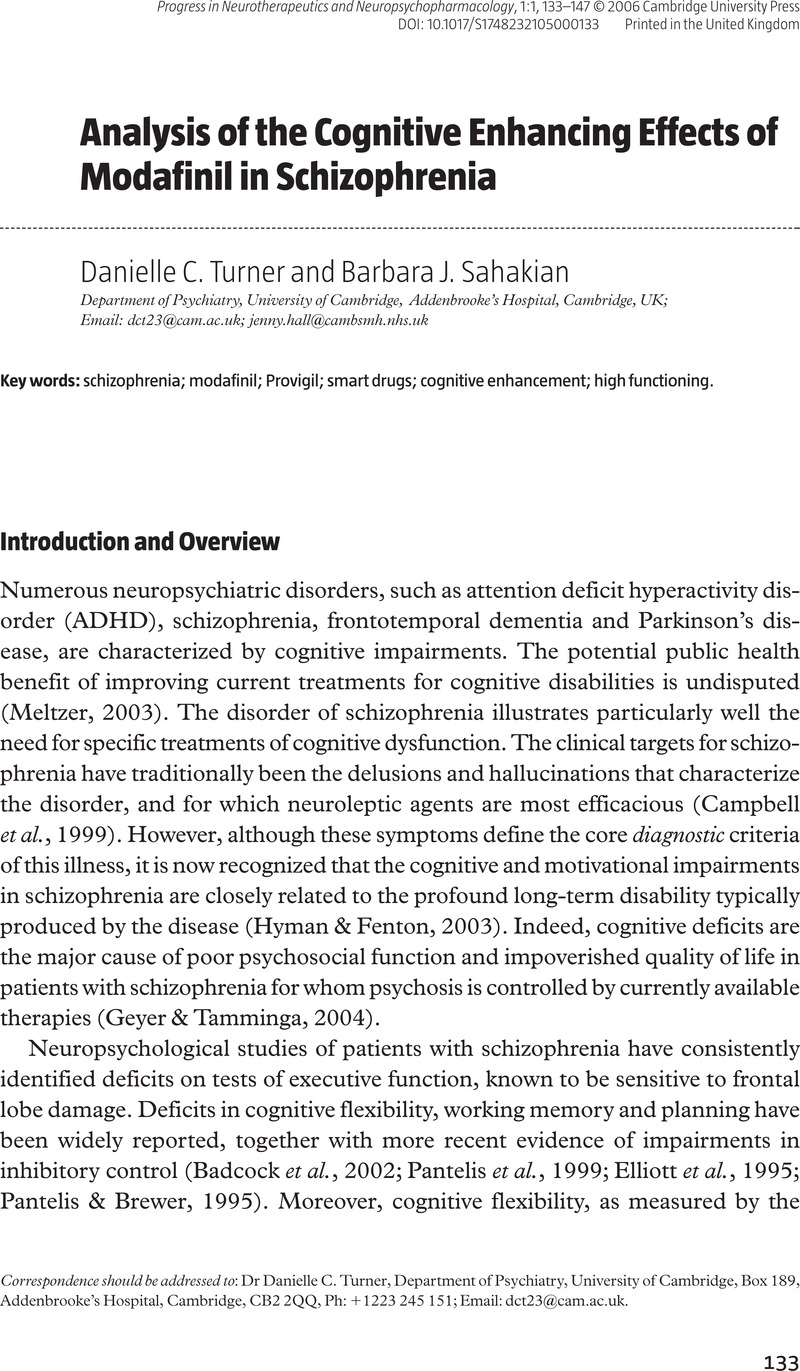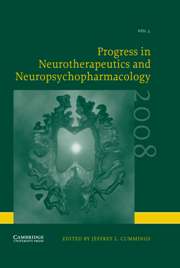No CrossRef data available.
Article contents
Analysis of the Cognitive Enhancing Effects of Modafinil in Schizophrenia
Published online by Cambridge University Press: 15 February 2006
Abstract
An abstract is not available for this content so a preview has been provided. Please use the Get access link above for information on how to access this content.

Information
- Type
- Review Article
- Information
- Progress in Neurotherapeutics and Neuropsychopharmacology , Volume 1 , Issue 1 , January 2006 , pp. 133 - 147
- Copyright
- © 2006 Cambridge University Press
References
Akaoka, H., et al. (1991). Effect of modafinil and amphetamine on the rat catecholaminergic neuron activity. Neuroscience Letters, 123 (1), 20–22.Google Scholar
American Psychiatric Association. (1994). Diagnostic and Statistical Manual of Mental Disorders (4th ed.). Washington, DC: American Psychiatric Press.
Andreasen, N.C., et al. (1992). The Comprehensive Assessment of Symptoms and History (CASH). An instrument for assessing diagnosis and psychopathology. Archives of General Psychiatry, 49 (8), 615–623.Google Scholar
Angrist, B., et al. (1982). Partial improvement in negative schizophrenic symptoms after amphetamine. Psychopharmacology (Berl), 78 (2), 128–130.Google Scholar
Badcock, J.C., et al. (2002). Acts of control in schizophrenia: dissociating the components of inhibition. Psychological Medicine, 32 (2), 287–297.Google Scholar
Bond, A., & Lader, M. (1974). The use of analogue scales in rating subjective feelings. British Journal of Medical Psychology, 47, 211–218.Google Scholar
Buchanan, R.W., et al. (1994). The comparative efficacy and long-term effect of clozapine treatment on neuropsychological test performance. Biological Psychiatry, 36 (11), 717–725.Google Scholar
Campbell, M., et al. (1999). The use of atypical antipsychotics in the management of schizophrenia. British Journal of Clinical Pharmacology, 47 (1), 13–22.Google Scholar
Carpenter, M.D., et al. (1992). Methylphenidate augmentation therapy in schizophrenia. Journal of Clinical Psychopharmacology, 12 (4), 273–275.Google Scholar
Chemelli, R.M., et al. (1999). Narcolepsy in orexin knockout mice: molecular genetics of sleep regulation. Cell, 98 (4), 437–451.Google Scholar
Davidson, M., & Keefe, R.S. (1995). Cognitive impairment as a target for pharmacological treatment in schizophrenia. Schizophrenia Research, 17 (1), 123–129.Google Scholar
Duteil, J., et al. (1990). Central alpha 1-adrenergic stimulation in relation to the behaviour stimulating effect of modafinil; studies with experimental animals. European Journal of Pharmacology, 180 (1), 49–58.Google Scholar
Elliott, R., et al. (1995). Neuropsychological evidence for frontostriatal dysfunction in schizophrenia. Psychological Medicine, 25 (3), 619–630.Google Scholar
Elliott, R., et al. (1997). Effects of methylphenidate on spatial working memory and planning in healthy young adults. Psychopharmacology (Berl), 131 (2), 196–206.Google Scholar
Evenden, J.L. (1999). Varieties of impulsivity. Psychopharmacology (Berl), 146 (4), 348–361.Google Scholar
Ferraro, L., et al. (1997). Modafinil: an antinarcoleptic drug with a different neurochemical profile to d-amphetamine and dopamine uptake blockers. Biological Psychiatry, 42 (12), 1181–1183.Google Scholar
Folstein, M.F., et al. (1975). Mini-mental state. A practical method for grading the cognitive state of patients for the clinician. Journal of Psychiatric Research, 12 (3), 189–198.Google Scholar
Geyer, M.A., & Tamminga, C.A. (2004). Measurement and treatment research to improve cognition in schizophrenia: neuropharmacological aspects. Psychopharmacology, 174 (1), 1–2.Google Scholar
Goldberg, T.E., et al. (1991). Cognitive and behavioral effects of the coadministration of dextroamphetamine and haloperidol in schizophrenia. American Journal of Psychiatry, 148 (1), 78–84.Google Scholar
Green, M.F. (1996). What are the functional consequences of neurocognitive deficits in schizophrenia? American Journal of Psychiatry, 153 (3), 321–330.Google Scholar
Hartman, M., et al. (2003). Wisconsin Card Sorting Test performance in schizophrenia: the role of working memory. Schizophrenia Research, 63 (3), 201–217.Google Scholar
Heaton, R.K., et al. (2001). Stability and course of neuropsychological deficits in schizophrenia. Archives of General Psychiatry, 58 (1), 24–32.Google Scholar
Howell, D.C. (1997). Statistical Methods for Psychology (4th ed.). London: Wadsworth Publishing Company.
Hyman, S.E., & Fenton, W.S. (2003). Medicine. What are the right targets for psychopharmacology? Science, 299 (5605), 350–351.Google Scholar
Ishizuka, T., et al. (2003). Modafinil increases histamine release in the anterior hypothalamus of rats. Neuroscience Letters, 339 (2), 143–146.Google Scholar
Jasinski, D.R. (2000). An evaluation of the abuse potential of modafinil using methylphenidate as a reference. Journal of Psychopharmacology, 14 (1), 53–60.Google Scholar
Koren, D., et al. (1998). Factor structure of the Wisconsin Card Sorting Test: dimensions of deficit in schizophrenia. Neuropsychology, 12 (2), 289–302.Google Scholar
Levy, D.L., et al. (1993). Methylphenidate increases thought disorder in recent onset schizophrenics, but not in normal controls. Biological Psychiatry, 34 (8), 507–514.Google Scholar
Lin, J.S., et al. (1992). Role of catecholamines in the modafinil and amphetamine induced wakefulness, a comparative pharmacological study in the cat. Brain Research, 591 (2), 319–326.Google Scholar
Lin, J.S., et al. (1996). Potential brain neuronal targets for amphetamine-, methylphenidate-, and modafinil-induced wakefulness, evidenced by c-fos immunocytochemistry in the cat. Proceedings of National Academy of Sciences of the United States of America, 93 (24), 14128–14133.Google Scholar
Luborsky, L. (1962). Clinician's judgments of mental health. Archives of General Psychiatry, 7, 407–417.Google Scholar
Makela, E.H., et al. (2003). Three case reports of modafinil use in treating sedation induced by antipsychotic medications. Journal of Clinical Psychiatry, 64 (4), 485–486.Google Scholar
Meltzer, H.Y. (2003). Beyond control of acute exacerbation: enhancing affective and cognitive outcomes. CNS Spectrums, 8 (11 Suppl. 2), 16–18, 22.Google Scholar
Muller, U., et al. (2004). Effects of modafinil on working memory processes in humans. Psychopharmacology (Berl), 177(1–2), 161–169.Google Scholar
Narendran, R., et al. (2002). Is psychosis exacerbated by modafinil? Archives of General Psychiatry, 59 (3), 292–293.Google Scholar
Nelson, H. (1982). National Adult Reading Test Manual. UK: Windsor NFER-Nelson.
Pantelis, C., & Brewer, W. (1995). Neuropsychological and olfactory dysfunction in schizophrenia: relationship of frontal syndromes to syndromes of schizophrenia. Schizophrenia Research, 17 (1), 35–45.Google Scholar
Pantelis, C., et al. (1999). Comparison of set-shifting ability in patients with chronic schizophrenia and frontal lobe damage. Schizophrenia Research, 37 (3), 251–270.Google Scholar
Provigil. (1997). Modafinil Datasheet. Date of first authorisation 14 October 1997.
Randall, D.C., et al. (2004). The cognitive-enhancing properties of modafinil are limited in non-sleep-deprived middle-aged volunteers. Pharmacology Biochemistry and Behavior, 77 (3), 547–555.Google Scholar
Scammell, T.E., et al. (2000). Hypothalamic arousal regions are activated during modafinil-induced wakefulness. Journal of Neuroscience, 20 (22), 8620–8628.Google Scholar
Sevy, S., et al. (2005). Double-blind, placebo-controlled study of modafinil for fatigue and cognition in schizophrenia patients treated with psychotropic medications. Journal of Clinical Psychiatry, 66 (7), 839–843.Google Scholar
Shelton, J., et al. (1995). Comparative effects of modafinil and amphetamine on daytime sleepiness and cataplexy of narcoleptic dogs. Sleep, 18 (10), 817–826.Google Scholar
Simon, P., et al. (1994). The stimulant effect of modafinil on wakefulness is not associated with an increase in anxiety in mice. A comparison with dexamphetamine. Psychopharmacology (Berl), 114 (4), 597–600.Google Scholar
Spaulding, W.D., et al. (1999). Cognitive functioning in schizophrenia: implications for psychiatric rehabilitation. Schizophrenia Bulletin, 25 (2), 275–289.Google Scholar
Spence, S.A., et al. (2005). Modafinil modulates anterior cingulate function in chronic schizophrenia. British Journal of Psychiatry, 187, 55–61.Google Scholar
Szeszko, P.R., et al. (1999). Longitudinal assessment of methylphenidate effects on oral word production and symptoms in first-episode schizophrenia at acute and stabilized phases. Biological Psychiatry, 45 (6), 680–686.Google Scholar
Tanganelli, S., et al. (1994). 6-hydroxy-dopamine treatment counteracts the reduction of cortical GABA release produced by the vigilance promoting drug modafinil in the awake freely moving guinea-pig. Neuroscience Letters, 171 (1–2), 201–204.Google Scholar
Tanganelli, S., et al. (1995). Modafinil and cortical gamma-aminobutyric acid outflow. Modulation by 5-hydroxytryptamine neurotoxins. European Journal of Pharmacology, 273 (1–2), 63–71.Google Scholar
Taylor, F.B., & Russo, J. (2000). Efficacy of modafinil compared to dextroamphetamine for the treatment of attention deficit hyperactivity disorder in adults. Journal of Child Adolescent Psychopharmacology, 10 (4), 311–320.Google Scholar
Turner, D.C., et al. (2003a). Relative lack of cognitive effects of methylphenidate in elderly male volunteers. Psychopharmacology (Berl), 168 (4), 455–464.Google Scholar
Turner, D.C., et al. (2003b). Cognitive enhancing effects of modafinil in healthy volunteers. Psychopharmacology (Berl), 165 (3), 260–269.Google Scholar
Turner, D.C., et al. (2004a). Modafinil improves cognition and response inhibition in adult attention-deficit/hyperactivity disorder. Biological Psychiatry, 55 (10), 1031–1040.Google Scholar
Turner, D.C., et al. (2004b). Modafinil improves cognition and attentional set shifting in patients with chronic schizophrenia. Neuropsychopharmacology, 29 (7), 1363–1373.Google Scholar
Wisor, J.P., & Eriksson, K.S. (2005). Dopaminergic–adrenergic interactions in the wake promoting mechanism of modafinil. Neuroscience, 132 (4), 1027–1034.Google Scholar
Wisor, J.P., et al. (2001). Dopaminergic role in stimulant-induced wakefulness. Journal of Neuroscience, 21 (5), 1787–1794.Google Scholar
Wykes, T., et al. (1999). The effects of neurocognitive remediation on executive processing in patients with schizophrenia. Schizophrenia Bulletin, 25 (2), 291–307.Google Scholar
Wykes, T., et al. (2000). The prevalence and stability of an executive processing deficit, response inhibition, in people with chronic schizophrenia. Schizophrenia Research, 46 (2–3), 241–253.Google Scholar
Wykes, T., et al. (2003). Are the effects of cognitive remediation therapy (CRT) durable? Results from an exploratory trial in schizophrenia. Schizophrenia Research, 61 (2–3), 163–174.Google Scholar
Yu, B.P., et al. (2002). Modafinil for treatment of the negative symptoms of schizophrenia and antipsychotic-induced sedation. Sleep, 25 (Abstract supplement), A503–A504.Google Scholar

